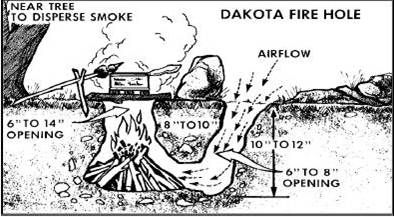Stealth Camping: Cookfire
If you do not wish to be detected out in the country or the hills (maybe you just want some time alone), the rules are almost the same as those that they taught you in basic. Sound and fire discipline being paramount. Other things matter, yes, however the most jarring thing for somebody out on patrol or for a stroll is smoke and/or light in the night. A single lit candle can be seen from very far off in the night. A campfire does not sound like a very good idea in this situation.
Just because you would prefer not being detected does not mean you have to do without warmth and hot meals.
Those that went before came up with an ingenious solution to this issue. I give to you, that which is popularly known as "Dakota Fire Pit" or by other names in many other places across the world. I have seen jungle tribals in central India do this (it is almost like a chulha).
What you do is dig a pit 6 inches in radius, a foot deep. Then about a foot away from the edge of this pit (windward side) you start a six inch wide tunnel sloping towards the initial pit. Keep going till the tunnel reaches the pit. In the original pit, about 5 inches deep into the hole, start widening the pit at the bottom so it starts looking like a conical flask from chemistry lab.
While doing all of this, it is advisable to build this under the canopy of a tree, but not at its base near the trunk.
At the base of the main pit, put in your firewood. till it gets to the point where you started widening the pit (so about the top 5 inches of the main pit wont have firewood in it). Place three green sticks around the pit opening to rest your cook pots on. Light the fire in the pit and start cooking.
The benefits here are as follows:
- The Dakota Fire Pit does not have a flame which can be seen from away, as the combustion is underground
- The Dakota Fire Pit has an inbuilt draft which ensures more complete combustion of the fuel (firewood) this eliminating a lot of smoke and a hotter burn, faster cooking and lesser blowing at the tinder to get it started (most times)
- Being under the tree, ensures that whatever little smoke does rise up, or steam from your pots, will get dissipated instead of rising in a column which can be seen for miles on a clear day.
A few Precautions:
Do not do this when :
- The ground is peaty. The peat will catch fire and you will be in serious trouble.
- There are a lot of roots, you will damage the roots of the trees and cause ecological damage as well as risk an underground traveling smoldering fire which can break out someplace and start a forest fire.
- The ground is lose and sandy or otherwise wont create a proper straight pit and tunnel (the contraption will collapse in on itself)
- Waterlogged ground where water will collect in the pit.
- When it looks like it will rain, or when it is raining (that would be plumb stupid)
- Rocks and stones in the soil (difficult to dig a proper hole and rocks can explode when heated)
- Ensure you put out the fire completely
- Back fill the pit and tunnel with the soil you set aside while excavating.
- The top layer of the pit and the tunnel can be kept intact (grass and debris and all) while starting them, these can be replaced on the back-filled pit and tunnel after the fire is done, to eliminate more tracks of you having been there.

^ image from http://thesurvivalplaceblog.com/2012/10 ... fographic/
- Guess the actual dimensions of the thing are not limited to the ones i have been using, however the image still explains the concept clearly.
Initial image used was http://i300.photobucket.com/albums/nn2/ ... 255083.gif was from http://www.fortressoffaith.org/wp-conte ... iagram.gif however it is not showing up on actual website anymore, only in google images.






